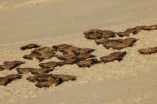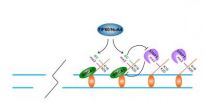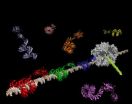(Press-News.org) New University of East Anglia research into the mating habits of a critically endangered sea turtle will help conservationists understand more about its mating patterns.
Research published today in Molecular Ecology shows that female hawksbill turtles mate at the beginning of the season and store sperm for up to 75 days to use when laying multiple nests on the beach.
It also reveals that these turtles are mainly monogamous and don't tend to re-mate during the season.
Because the turtles live underwater, and often far out to sea, little has been understood about their breeding habits until now. The breakthrough was made by studying DNA samples taken from turtles on Cousine Island in the Seychelles.
The hawksbill turtle (Eretmochelys imbricata) was listed as critically endangered in 1996 by the International Union for Conservation of Nature (IUCN), largely due to a dramatic reduction in their numbers driven by the international trade in tortoiseshell as a decorative material – an activity which was banned in the same year.
The Seychelles are home to the largest remaining population of hawksbill turtles in the western Indian Ocean. Cousine Island is an important nesting ground for the hawksbill and has a long running turtle monitoring program. It is hoped that the research will help focus conservation efforts in future.
Lead researcher Dr David Richardson, from UEA's school of Biological Sciences, said: "We now know much more about the mating system of this critically endangered species. By looking at DNA samples from female turtles and their offspring, we can identify and count the number of breeding males involved. This would otherwise be impossible from observation alone because they live and mate in the water, often far out to sea.
"We now know that female turtles mate at the beginning of the season - probably before migrating to the nesting beaches. They then store sperm from that mating to use over the next couple of months when laying multiple nests.
"Our research also shows that, unlike in many other species, the females normally mate with just one male, they rarely re-mate within a season and they do not seem to be selecting specific 'better quality' males to mate with.
"Understanding more about when and where they are mating is important because it will help conservationists target areas to focus their efforts on.
"It also lets us calculate how many different males contribute to the next generation of turtles, as well as giving an idea of how many adult males are out there, which we never see because they live out in the ocean.
"Perhaps most importantly, it gives us a measure of how genetically viable the population is - despite all the hunting of this beautiful and enigmatic species over the last 100 years.
"The good news is that each female is pairing up with a different male – which suggests that there are plenty of males out there. This may be why we still see high levels of genetic variation in the population, which is crucial for its long term survival .This endangered species does seem to be doing well in the Seychelles at least."
Lead author Karl Phillips, a PhD student in UEA's school of Biological Sciences, added: "This is an excellent example of how studying DNA can reveal previously unknown aspects of species' life histories."
INFORMATION:
The research was funded by UEA and the Natural Environment Research Council (NERC) Biomolecular Analysis Facility (NBAF).
'Reconstructing paternal genotypes to infer patterns of sperm storage and sexual selection in the hawksbill turtle' by David S. Richardson, Karl P. Phillips, and Tove H.Jorgensen (all UEA) and Kevin G. Jolliffe, San-Marie Jolliffe and Jock Henwood (Cousine Island) is published by the journal Molecular Ecology on Monday, February 4, 2012.
DNA reveals mating patterns of critically endangered sea turtle
2013-02-04
ELSE PRESS RELEASES FROM THIS DATE:
Changes to DNA on-off switches affect cells' ability to repair breaks, respond to chemotherapy
2013-02-04
PHILADELPHIA - Double-strand breaks in DNA happen every time a cell divides and replicates. Depending on the type of cell, that can be pretty often. Many proteins are involved in everyday DNA repair, but if they are mutated, the repair system breaks down and cancer can occur. Cells have two complicated ways to repair these breaks, which can affect the stability of the entire genome.
Roger A. Greenberg, M.D., Ph.D., associate investigator, Abramson Family Cancer Research Institute and associate professor of Cancer Biology at the Perelman School of Medicine, University of ...
Researchers discover mutations linked to relapse of childhood leukemia
2013-02-04
After an intensive three-year hunt through the genome, medical researchers have pinpointed mutations that leads to drug resistance and relapse in the most common type of childhood cancer—the first time anyone has linked the disease's reemergence to specific genetic anomalies.
The discovery, co-lead by William L. Carroll, MD, director of NYU Langone Medical Center's Cancer Institute, is reported in a study published online February 3, 2013, in Nature Genetics.
"There has been no progress in curing children who relapse, in spite of giving them very high doses of chemotherapy ...
Pioneering research helps to unravel the brain's vision secrets
2013-02-04
A new study led by scientists at the Universities of York and Bradford has identified the two areas of the brain responsible for our perception of orientation and shape.
Using sophisticated imaging equipment at York Neuroimaging Centre (YNiC), the research found that the two neighbouring areas of the cortex -- each about the size of a 5p coin and known as human visual field maps -- process the different types of visual information independently.
The scientists, from the Department of Psychology at York and the Bradford School of Optometry & Vision Science established ...
Immune cell 'survival' gene key to better myeloma treatments
2013-02-04
Scientists have identified the gene essential for survival of antibody-producing cells, a finding that could lead to better treatments for diseases where these cells are out of control, such as myeloma and chronic immune disorders.
The discovery that a gene called Mcl-1 is critical for keeping this vital immune cell population alive was made by researchers at Melbourne's Walter and Eliza Hall Institute. Associate Professor David Tarlinton, Dr Victor Peperzak and Dr Ingela Vikstrom from the institute's Immunology division led the research, which was published today in ...
Growth factor aids stem cell regeneration after radiation damage
2013-02-04
DURHAM, N.C. – Epidermal growth factor has been found to speed the recovery of blood-making stem cells after exposure to radiation, according to Duke Medicine researchers. The finding could open new options for treating cancer patients and victims of dirty bombs or nuclear disasters.
Reported in the Feb. 3, 2013, issue of the journal Nature Medicine, the researchers explored what had first appeared to be an anomaly among certain genetically modified mice with an abundance of epidermal growth factor in their bone marrow. The mice were protected from radiation damage, and ...
Recreating natural complex gene regulation
2013-02-04
DURHAM, N.C. – By reproducing in the laboratory the complex interactions that cause human genes to turn on inside cells, Duke University bioengineers have created a system they believe can benefit gene therapy research and the burgeoning field of synthetic biology.
This new approach should help basic scientists as they tease out the effects of "turning on" or "turning off" many different genes, as well as clinicians seeking to develop new gene-based therapies for human disease.
"We know that human genes are not just turned on or off, but can be activated to any level ...
Plant scientists at CSHL demonstrate new means of boosting maize yields
2013-02-04
Cold Spring Harbor, NY – A team of plant geneticists at Cold Spring Harbor Laboratory (CSHL) has successfully demonstrated what it describes as a "simple hypothesis" for making significant increases in yields for the maize plant.
Called corn by most people in North America, modern variants of the Zea mays plant are among the indispensable food crops that feed billions of the planet's people. As global population soars beyond 6 billion and heads for an estimated 8 to 9 billion by mid-century, efforts to boost yields of essential food crops takes on ever greater potential ...
Poor mental health leads to unhealthy behaviors among low-income adults
2013-02-04
Poor mental health leads to unhealthy behaviors in low-income adults – not the other way around, according to a new study¹ by Dr. Jennifer Walsh and colleagues from the Centers for Behavioral and Preventive Medicine at The Miriam Hospital in the US. In this study, stress and anxiety predicted subsequent health-compromising behaviors, such as smoking, binge drinking, illegal drug use, unprotected sex and unhealthy diets. One possible explanation for these findings is that health compromising behaviors may be used as coping mechanisms to manage the effects of stress and anxiety. ...
Monell scientists identify elusive taste stem cells
2013-02-04
PHILADELPHIA (February 4, 2013) – Scientists at the Monell Center have identified the location and certain genetic characteristics of taste stem cells on the tongue. The findings will facilitate techniques to grow and manipulate new functional taste cells for both clinical and research purposes.
"Cancer patients who have taste loss following radiation to the head and neck and elderly individuals with diminished taste function are just two populations who could benefit from the ability to activate adult taste stem cells," said Robert Margolskee, M.D., Ph.D., a molecular ...
Geographic factors can cause allergies, asthma
2013-02-04
ARLINGTON HEIGHTS, Ill. (February 4, 2013) – Those living near the equator may find themselves sneezing and wheezing more than usual. And the reason may not be due to increasing pollen counts. According to a new study released today, in the February issue of Annals of Allergy, Asthma & Immunology, the scientific journal of the American College of Allergy, Asthma and Immunology (ACAAI), living in locations closest to the equator can put you at increased risk of developing allergy and asthma.
"UV-B rays exposure is higher for people living in areas closer to the equator," ...


